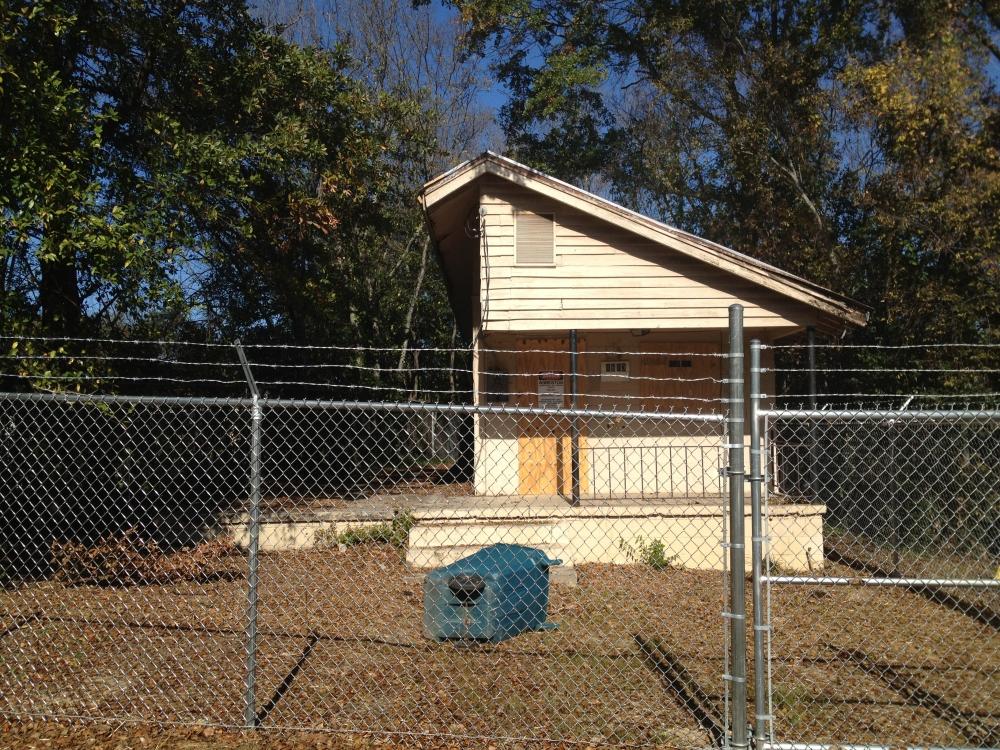
Section Branding
Header Content
Macon Interstate Project Opens Old Wound
Primary Content

Looming highway construction plans in Macon are heating up long-simmering resentment in the neighborhood that will be most affected, and reviving memories of what some call a dark page in America’s transportation history.
The junction between Interstates 16 and 75 on Macon’s east side is known as one of the most deadly interchanges in Georgia. But to rebuild it, the Georgia Department of Transportation will have to make room by moving or demolishing 27 buildings in Macon’s Pleasant Hill neighborhood, most of them homes.
It won’t be the first time.
A Metaphor In Yellow Siding
Historic Macon Foundation executive director Josh Rogers drives through dimly-lit streets in Pleasant Hill, having an architecture-geek moment.
“Isn’t that a cool house?” he asks wistfully, gazing wide-eyed out the windshield. “A little gabled L-cottage, there’s a bungalow, there’s a shotgun house…”
This was one of the first historically black neighborhoods to make it on the National Register of Historic Places. After the Civil War, Macon’s emerging black professional class built small but stately homes in Pleasant Hill.
Notable early residents of the neighborhood include Jefferson Franklin Long, Georgia’s first black congressman. A few decades later, “Little” Richard Penniman was born here, and proceeded to give birth to rock n’ roll.
Then, in the 1960s, came I-75 – it cut a canyon straight through the middle.
What remains on either side today is mostly a mix of retirees who never left and low-income people who can’t afford to live anywhere else.
Streets off the original grid dead-end against what feels—in the dark—like the edge of the world. And then, there’s this thing I’ve heard about, but haven’t seen until now.
“Stop right here!” Yolanda “Y.O.” Latimore instructs Rogers from the backseat.
Another member of Macon’s energetic (and surprisingly young) community of preservationists, Latimore’s parents hale from Pleasant Hill. Like many of her peers who grew up elsewhere, she feels a strong multi-generational connection to the neighborhood.
“Can you see it?” she asks me, as I peer into the night beyond the front passenger’s seat window.
“My god,” I say with sincere amazement, “that’s a half a house.”
“Ha!” Latimore laughs, heartily. “It’s much different in person.”
The “half-a-house” is actually what people call this metaphor in yellow siding by the interstate. Why GDOT only demolished the side that faced the highway is unknown. But crews recently put a fence around the property; nearly 50 years later, they’re coming back for the other half.
“I think people may have asked that it stay there, or somebody maybe later on says ‘hey, we’re gonna preserve this and show what an impact this interstate had on us in the late 1960s,’” Latimore says, recounting spotty neighborhood lore. “But it doesn’t seem like it avoided, uh, future problems. Like, the reminder didn’t work!”
Rogers concurs in an ominous tone, "right."
‘We Done Had Enough’
In a school cafeteria (still in Pleasant Hill but feeling worlds away on the other side of I-75) GDOT project manager Clinton Ford futzes with an uncooperative microphone at a community Q & A.
“Can you hear me?” he asks a sea of skeptical faces.
“Anyone who wants to know the specific impacts to their properties or their homes, we’ll have people around after we break the question and answer session,” Ford says, trying to keep things on track.
He doesn’t have much luck with 82-year-old Minnie Grinell.
“If you had designed it right in the first place you wouldn’t be coming back through Pleasant Hill,” the tiny woman proclaims in southern black dialect from a bygone era. “We done had enough, and enough is enough! If I have to get out there in the wheelchair and roll up and down the street, it’s enough!”
Grinell’s toss of the gauntlet draws a few weary, murmured “AY-mens.”
Another elderly neighbor, Margaret Thompson, demands of the GDOT representatives: why don’t you build through Vineville, or downtown? That is, whiter neighborhoods.
“No, this only happens in the black community,” Thompson says with disgust. “We don’t even get a break, we don’t be consulted or nothing. And this racism keeps going on and on and on.”
GDOT’s Clinton Ford, himself African American, struggles to explain that decisions of the past limit options in the present.
“Uh, well, the interstate needs to be widened. And unfortunately, Pleasant Hill is on either side of the interstate,” Ford fumbles, stating the obvious and visibly feeling the heat. “There were several design alternatives that were considered, but uh, this was the preferred design, and all of them would have impacted Pleasant Hill.”
‘This Is Endemic In America’
But it’s no accident that the interstate came through Pleasant Hill the first time in the 1960s, says Historic Macon’s Josh Rogers.
“This is endemic in America,” Rogers says. “The interstates came through the lowest-cost neighborhoods because they were the least politically organized, and most of them were black.”
GDOT is not oblivious to the historical context. They plan to spend $10 million making it up to Pleasant Hill – installing sidewalks, landscaping, a heritage trail, and more. There are plans to preserve one of Little Richard’s two boyhood homes in the neighborhood as a community center.
This time around, GDOT promises a just and inclusive process.
Still, the elderly Ms. Grinell says it doesn’t matter if she gets input on which textured pattern is on her new highway noise barriers – the interstate is coming again, and again, she had no choice.
“They’re just tryin’ to take your freedom away from you, we fought too long for our freedom,” Grinell squeaks mutedly, gesturing to the tense community meeting still going on down a reverberating school hallway.
“To just be [told], ‘well I want it, and I’m is gonna get it,’ it’s not right,” she says, shaking her head. “It’s not.”
GDOT is buying up properties in the footprint of the new interchange now. The plan is to start moving houses in 2014.
Tags: Georgia Department of Transportation, racism, Adam Ragusea, Pleasant Hill, Interstate 75
Bottom Content

